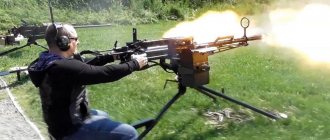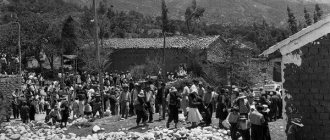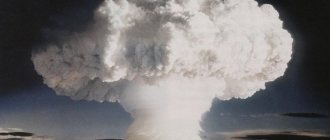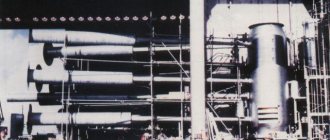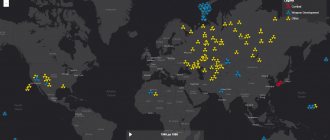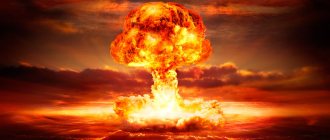High explosive and explosive action of explosion
It is convenient to combine numerous forms of mechanical work of explosion products into two main groups: high-explosive and blasting.
If the energy characteristics of explosives determine their potential capabilities, i.e. the ability to do some work (destruction, throwing, etc.), then the characteristics of brisance and high explosiveness make it possible to evaluate the characteristics of energy release, i.e. Based on their meaning, one can get an idea of the very process of doing work by explosion products.
Brisance
- this is the ability of explosives (more precisely, their gaseous explosion products) to have a local destructive effect, which is the result of a sharp impact of detonation products on the surrounding explosive environment.
The blasting effect of explosives manifests itself only at a close distance from the explosion site, where the pressure and energy density of the gaseous products of the explosion are high. The maximum brisance effect occurs when the explosive charge is in direct contact with the environment, provided that the detonation wave propagates in a direction perpendicular to the target. The external manifestation of brisance is the fragmentation of the medium. Experience shows that the blasting effect depends on the energy characteristics of explosives, their density, detonation speed and the pressure of gaseous explosion products at the front of the detonation wave (sometimes called “detonation” pressure).
Many researchers have proposed characteristics for assessing brisance. Cast proposed to first determine the brisance ( VP
) according to the formula
, (W/m3
), (2.45)
where P
– explosive potential (J/kg),
po
— explosive density (kg/m3),
t
— time of passage of the detonation wave, s.
Later, Kast proposed replacing the potential with a force (¦) equal to ¦= RT
explosion and assume that the explosion time
t
is inversely proportional to the detonation speed (
D
). Taking this into account, we can write
, ( ) . (2.46)
Snitko, considering that between P
and
f
there is no direct proportionality, he suggested
using the heat of explosion
QV
P , and expressing the explosion time not only through the detonation speed (
D
), but also through the linear size of the charge
lo,
for example its length:
, ( ). (2.47)
IN -
is called the energy stress during an explosion.
Formulas (2.45-2.47) are used to quantify brisance. However, they are all to some extent conditional. Experimental characteristics are often used to assess brisance.
The simplest and most common method of testing for brisance
is a test for compression of lead columns (Hess test, see Fig. 2.9). For testing, lead posts (2) with a diameter of 40 mm and a height of 60 mm are used. The lead column is placed on a massive steel plate (1) in a vertical position. A steel plate (3) with a thickness of 10 mm and a diameter of 41 mm is placed on the column, on which a charge (4) of the tested explosive weighing 50 g in a paper shell with a diameter of 40 mm is installed. When an explosive charge explodes (initiated by a detonation cord (5)), the lead column is deformed. A measure of the brisance of an explosive is the amount of compression, i.e. difference in column heights before and after compression:
В= h1 – h2
, (2.48)
where h1
– column height before explosion equal to 60 mm,
h2
— height of the column after the explosion.
P.F. Pokhil and M.A. Sadovsky recommend assessing brisance ( B
) size
a.
Function
“a”
takes into account the increase in column resistance as compression occurs:
a =
, (2.48)
where D h
– the amount of compression of the column, i.e.
brisance, h1
– column height before compression,
h2
– column height after compression.
Figure 2.10 — Assembly diagram for testing for brisance using the Hess test:
a- before the explosion, b- after the explosion
1 - steel plate, 2 - lead column before compression, 2/ - lead column after compression, 3 - steel plate, 4 - explosive charge, 5 - detonation cord (tetryl detonator)
When testing explosives with low detonation ability, the Hess test is slightly modified by placing the explosive in steel rings in an amount of 100 g, while the charge length increases slightly (~2 times). If the explosive's sensitivity to the detonator capsule is low, pressed tetryl blocks weighing 5 g are used to initiate detonation.
To bring laboratory experimental conditions closer to production ones, L.I. Baron, B.D. Rossi and S.P. Levchik proposed a method for assessing the blasting effect of industrial explosives by crushing rock cubes (see Figure 2.11).
According to this method, charge (2) of the explosive being tested weighing 20 g is placed in a channel in the center of the cube (3). The entire free part of the channel is filled with a stopper (1). Before the experiment begins, the cubes are accurately weighed and exploded in a durable steel vessel (such as a Dolgov bomb). After the explosion, all destroyed material is removed from the bomb and subjected to sieve analysis.
Usually the total mass yield (in%) of fractions with a particle size of 5-7 mm is determined.
Figure 2.11 — Assembly for rock block crushing test:
1- ramming, 2- explosive charge, 3- rock cube
High explosiveness
is called the ability of an explosive to have a destructive effect due to the expansion of explosion products to relatively low pressures and the passage of a shock wave through the medium.
The high explosive effect manifests itself in the form of splitting and throwing away the medium in which the explosion occurs. explosiveness
often called
performance
.
As a measure of high explosiveness in theoretical calculations, potential (or the value of potential energy) P
(
E
) explosive or its specific energy
U1.
Experience shows that, in addition to the potential
P
(
E
) or specific energy
U1,
the high-explosive effect is significantly influenced by such characteristics as the specific volume and composition of the gaseous products of the explosion. For practical assessment of high explosiveness (relative performance), the so-called lead bomb expansion test (Trauzl test) is used.
Standard sample –
this is a cylinder measuring 20x20 cm2 with an axial hole with a diameter of 2.5 and a height of 12.5 cm. The test charge with a mass of M = 10 g is placed at the bottom of the bomb channel and covered with dry quartz sand, which acts as a stopper.
The measure of explosive performance is taken to be the increment in cavity volume in cubic centimeters ( DV
) minus the expansion produced by the detonator (
Vd
):
Af
=
DV - Vd.
(2.49)
Brisiness values B
(mm)
a
and high explosiveness
Af
(cm3) are given below.
| Explosive substance | Brisance | High explosiveness, cm3 | |
| V , mm | A | ||
| TNT | 16 | 0,364 | 285-310 |
| RDX | — | — | 475-495 |
| Ammonit 6ZhV | 14 | 0,305 | 360-380 |
| Detonit M | 17 | 0,396 | 440-460 |
Currently, the ejection funnel
and the
TNT equivalent method.
The ejection funnel is characterized by the ratio of its radius ( r
) to depth (
G
), which is called
the explosion action indicator.
The volume of the ejection funnel
V
depends on the mass and location of the charge, the properties of the explosive and the physicochemical properties of the environment in which the explosion is carried out. Comparison of performance is carried out according to the formula
a/ae
=
qе /q,
(2.50)
where q
– the mass of charge required to eject a unit volume of soil required through the so-called standard emission funnels (
r/G=1
).
TNT equivalent is a relative value showing what mass of TNT is equivalent to a unit of mass of the explosive under study in terms of intensity generated during a shock wave explosion:
CT
= . (2.51)
The intensity is determined by the magnitude of the pressure change at the shock wave front.
For simplicity, sometimes CT
characterized by the ratio of the heat of explosion of the explosive under study to the heat of explosion of TNT.
* M
* - average molecular weight of explosion products
An excerpt characterizing High Explosiveness
“Where did he go? Where is he now?..” When the dressed, washed body lay in a coffin on the table, everyone came up to him to say goodbye, and everyone cried. Nikolushka cried from the painful bewilderment that tore his heart. The Countess and Sonya cried out of pity for Natasha and that he was no more. The old count cried that soon, he felt, he would have to take the same terrible step. Natasha and Princess Marya were also crying now, but they were not crying from their personal grief; they wept from the reverent emotion that gripped their souls before the consciousness of the simple and solemn mystery of death that had taken place before them. The totality of causes of phenomena is inaccessible to the human mind. But the need to find reasons is embedded in the human soul. And the human mind, without delving into the innumerability and complexity of the conditions of phenomena, each of which separately can be represented as a cause, grabs the first, most understandable convergence and says: this is the cause. In historical events (where the object of observation is the actions of people), the most primitive convergence seems to be the will of the gods, then the will of those people who stand in the most prominent historical place - historical heroes. But one has only to delve into the essence of each historical event, that is, into the activities of the entire mass of people who participated in the event, to be convinced that the will of the historical hero not only does not guide the actions of the masses, but is itself constantly guided. It would seem that it is all the same to understand the significance of the historical event one way or another. But between the man who says that the peoples of the West went to the East because Napoleon wanted it, and the man who says that it happened because it had to happen, there is the same difference that existed between the people who argued that the earth stands firmly and the planets move around it, and those who said that they do not know what the earth rests on, but they know that there are laws governing the movement of it and other planets. There are no and cannot be reasons for a historical event, except for the only cause of all reasons. But there are laws that govern events, partly unknown, partly groped by us. The discovery of these laws is possible only when we completely renounce the search for causes in the will of one person, just as the discovery of the laws of planetary motion became possible only when people renounced the idea of \u200b\u200bthe affirmation of the earth. After the Battle of Borodino, the enemy’s occupation of Moscow and its burning, historians recognize the most important episode of the War of 1812 as the movement of the Russian army from the Ryazan to the Kaluga road and to the Tarutino camp - the so-called flank march behind Krasnaya Pakhra. Historians attribute the glory of this ingenious feat to various individuals and argue about who, in fact, it belongs to. Even foreign, even French historians recognize the genius of the Russian commanders when speaking about this flank march. But why military writers, and everyone after them, believe that this flank march is a very thoughtful invention of some one person, which saved Russia and destroyed Napoleon, is very difficult to understand. In the first place, it is difficult to understand wherein lies the profundity and genius of this movement; for in order to guess that the best position of the army (when it is not attacked) is where there is more food, it does not require much mental effort. And everyone, even a stupid thirteen-year-old boy, could easily guess that in 1812 the most advantageous position of the army, after the retreat from Moscow, was on the Kaluga road. So, it is impossible to understand, firstly, by what conclusions historians reach the point of seeing something profound in this maneuver. Secondly, it is even more difficult to understand exactly what historians see as the salvation of this maneuver for the Russians and its detrimental nature for the French; for this flank march, under other preceding, accompanying and subsequent circumstances, could have been disastrous for the Russians and salutary for the French army. If from the time this movement took place, the position of the Russian army began to improve, then it does not follow from this that this movement was the reason for this.
Classification of explosives
According to their explosive properties, explosives are divided into:
Initiating. They are used to detonate other explosives. The main differences between explosives of this group are their high sensitivity to initiating factors and high detonation speed. This group includes: mercury fulminate, diazodinitrophenol, lead trinitroresorcinate and others. As a rule, these compounds are used in igniter caps, ignition tubes, detonator caps, squibs, and self-destructors; High explosives. This type of explosive has a significant level of high explosive and is used as the main charge for the vast majority of ammunition. These powerful explosives differ in their chemical composition (N-nitramines, nitrates, other nitro compounds). Sometimes they are used in the form of various mixtures. High explosives are also actively used in mining, when laying tunnels, and carrying out other engineering work; Propellant explosives. They are a source of energy for throwing shells, mines, bullets, grenades, as well as for the movement of missiles. This class of explosives includes gunpowder and various types of rocket fuel; Pyrotechnic compositions. Used to equip special ammunition. When burned, they produce a specific effect: lighting, signaling, incendiary.
Explosives are also divided according to their physical state into:
Liquid. For example, nitroglycol, nitroglycerin, ethyl nitrate. There are also various liquid mixtures of explosives (panclastite, Sprengel explosives); Gaseous; Gel-like. If you dissolve nitrocellulose in nitroglycerin, you get the so-called explosive jelly. This is an extremely unstable, but quite powerful explosive gel-like substance. Russian revolutionary terrorists loved to use it at the end of the 19th century; Suspensions. A fairly large group of explosives that are used today for industrial purposes. There are various types of explosive suspensions in which the explosive or oxidizer is a liquid medium; Emulsion explosives. A very popular type of explosive these days. Often used in construction or mining work; Solid. The most common group of explosives. This includes almost all explosives used in military affairs. They can be monolithic (TNT), granular or powdery (RDX); Plastic. This group of explosives has plasticity. Such explosives are more expensive than regular ones, so they are rarely used to fill ammunition. A typical representative of this group is plastid (or plastite). It is often used during sabotage to undermine structures. In terms of its composition, plastid is a mixture of hexogen and some kind of plasticizer; Elastic.
